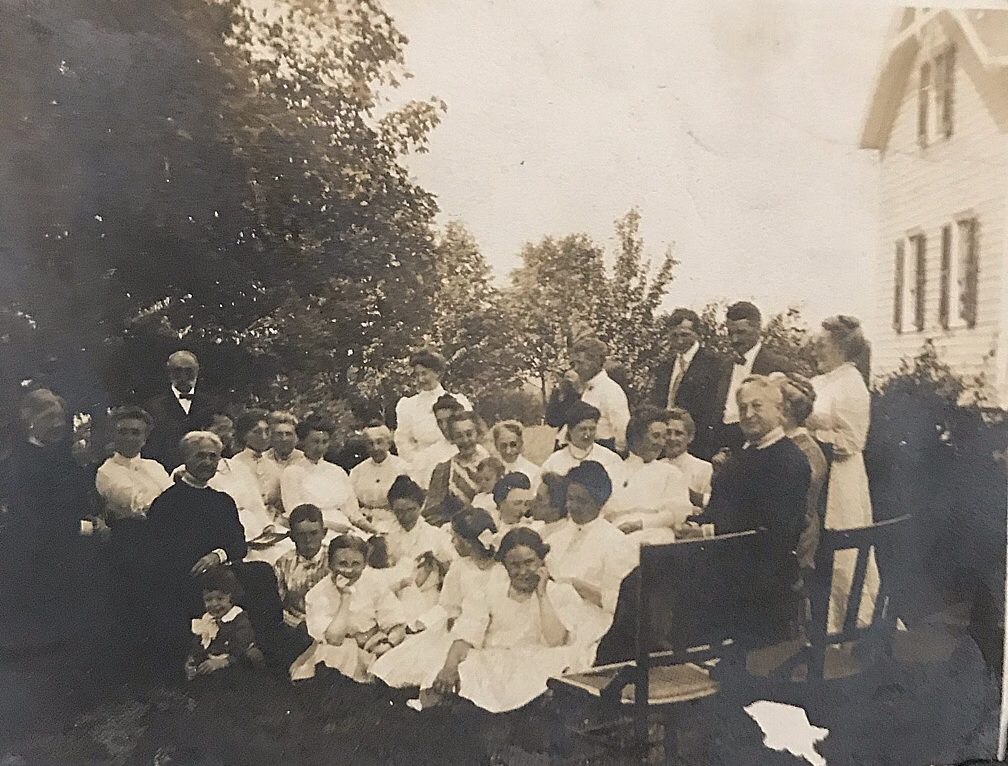They rested. Hard-working farming family that they were, it’s clear that at the beginning of the 20th century, the Dunnings observed the sabbath. Almost every time a relative is mentioned in the Middletown newspapers of those days it concerns an event at the First Presbyterian Church.
The picture below shows what I believe to be a church party, likely on a Sunday. I don’t recognize any relatives but it’s my assumption that those are fellow church members. (I also assume they’ve clumped together to be included in the photograph).
Two things stand out to me about this shot. One, the look of satisfaction of the man on the right side. He may not be the pastor but he wears a sort of ‘proud of my flock’ look, no? Two, the girls who are sitting on the ground balancing their heads on their hands. “How much longer do we have to sit here?”

It’s just a picture, of course. That juxtaposition, though – the difference between the older generation’s view of the church and the newer – comes through loud and clear in two novels of the time.
Here’s a quote from Room With a View by E.M. Forster (published in 1908): “Paganism is infectious – more infectious than diphtheria or piety – and the Rector’s niece was taken to church protesting. As usual, she didn’t see why. Why shouldn’t she sit in the sun with the young men?” The Rector’s niece found church boring, and Lily Bart from Edith Wharton’s 1905 novel House of Mirth agrees with that assessment.
“Lily, oppressed by the close atmosphere, and the stifling odour of fresh mourning, felt her attention straying as Mrs. Peniston’s lawyer, solemnly erect behind the Buhl table at the end of the room, began to rattle through the preamble of the will. ‘It’s like being in church,’ she reflected, wondering vaguely where Gwen Stepney had got such an awful hat.”
Already, in the early 1900’s there was an opting-out of religion for one or the other reason. In Lily Bart’s set, those reasons were as varied as shampooing one’s hair, playing tennis or “smoking the cigarette of young despair” in one’s bedroom. In the Forster novel, opposition is intellectual.
Lucy’s fiance Cecil respects “honest orthodoxy” but only as a “result of a spiritual crisis; he could not imagine it as a natural birthright, that might grow heavenward like flowers.” In other words, he looks down on Lucy for accepting her parent’s religion wholesale.
“Victorian earnestness gives way to modern irony and indifference.” writes Pericles Lewis in an essay entitled “Modernism and religion”. Modernists wanted to turn conventionality on its head. That meant the questioning of things that were givens for their Victorian-age parents…things like regular church attendance.
It certainly struck me reading these novels that turning away from the ritual of church life in the U.S. was already well underway by 1905. That’s not to say, Lewis argues, that Modernists were complete secularists. On the contrary, he argues that they simply “came to define their religion in increasingly personal terms” so that “the sacred no longer has its former public role.”
Where has this led in 2019? Binge-watching as spiritual ritual? Facebook for social belonging? Oprah for belief? It’s easy (but not helpful) to be too cynical. All I know is that when I look through the pictures on my phone I don’t have any that look like the one above…and I wish I did.

Great blog. I love the way you tited in the novels of the time.